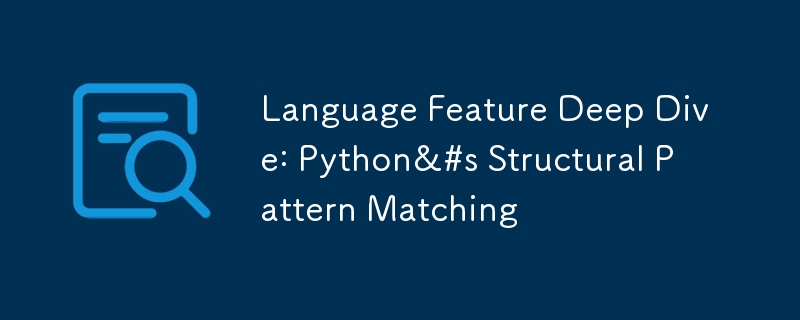Language Feature Deep Dive: Python&#s Structural Pattern Matching
来源:dev.to
时间:2024-10-02 21:31:12 191浏览 收藏
对于一个文章开发者来说,牢固扎实的基础是十分重要的,golang学习网就来带大家一点点的掌握基础知识点。今天本篇文章带大家了解《Language Feature Deep Dive: Pythons Structural Pattern Matching》,主要介绍了,希望对大家的知识积累有所帮助,快点收藏起来吧,否则需要时就找不到了!

各位开发者大家好!今天,我们将深入探讨 python 的一项更新且更令人兴奋的功能:结构模式匹配。此功能在 python 3.10 中引入,为处理复杂数据结构提供了一种强大且富有表现力的方式。让我们探讨一下它的工作原理以及如何在您的项目中使用它。
什么是结构模式匹配?
结构模式匹配是一种检查数据结构并根据其形状和内容执行代码的方法。它与其他语言中的 switch 语句类似,但功能更强大。通过模式匹配,您可以:
- 与数据类型匹配
- 解构复杂的数据结构
- 使用通配符和 or 模式
- 在模式内绑定变量
让我们看一些示例,看看这在实践中是如何运作的。
基本语法
模式匹配的基本语法使用 match 和 case 关键字:
def describe_type(data):
match data:
case int():
return "it's an integer"
case str():
return "it's a string"
case list():
return "it's a list"
case _:
return "it's something else"
print(describe_type(42)) # output: it's an integer
print(describe_type("hello")) # output: it's a string
print(describe_type([1, 2, 3])) # output: it's a list
print(describe_type({1, 2, 3})) # output: it's something else
在此示例中,我们匹配不同的类型。最后一种情况中的 _ 是匹配任何内容的通配符。
解构
模式匹配最强大的方面之一是它解构复杂数据结构的能力:
def process_user(user):
match user:
case {"name": str(name), "age": int(age)} if age >= 18:
return f"{name} is an adult"
case {"name": str(name), "age": int(age)}:
return f"{name} is a minor"
case _:
return "invalid user data"
print(process_user({"name": "alice", "age": 30})) # output: alice is an adult
print(process_user({"name": "bob", "age": 15})) # output: bob is a minor
print(process_user({"name": "charlie"})) # output: invalid user data
在这里,我们正在解构字典并在此过程中绑定变量。我们还使用守卫(如果年龄 >= 18)为案例添加附加条件。
或模式
您可以使用 |运算符在单个案例中指定多个模式:
def classify_number(num):
match num:
case 0 | 1 | 2:
return "small number"
case int(x) if x > 1000:
return "big number"
case int():
return "medium number"
case _:
return "not a number"
print(classify_number(1)) # output: small number
print(classify_number(500)) # output: medium number
print(classify_number(1001)) # output: big number
print(classify_number("hello")) # output: not a number
匹配序列
模式匹配对于处理列表或元组等序列特别有用:
def analyze_sequence(seq):
match seq:
case []:
return "Empty sequence"
case [x]:
return f"Single-element sequence: {x}"
case [x, y]:
return f"Two-element sequence: {x} and {y}"
case [x, *rest]:
return f"Sequence starting with {x}, followed by {len(rest)} more elements"
print(analyze_sequence([])) # Output: Empty sequence
print(analyze_sequence([1])) # Output: Single-element sequence: 1
print(analyze_sequence([1, 2])) # Output: Two-element sequence: 1 and 2
print(analyze_sequence([1, 2, 3, 4])) # Output: Sequence starting with 1, followed by 3 more elements
此示例展示了如何匹配不同长度的序列以及如何使用 * 运算符捕获剩余元素。
结论
结构模式匹配是一项强大的功能,可以使您的代码更具可读性和表现力,特别是在处理复杂的数据结构时。它在以下场景中特别有用:
- 解析命令行参数
- 实现状态机
- 使用抽象语法树
- 处理结构化数据(例如,来自 api 的 json 响应)
现在轮到你了!您在项目中如何使用(或计划如何使用)结构模式匹配?在下面的评论中分享您的经验或想法。您是否发现此功能有任何特别巧妙的用途?你遇到过什么挑战吗?我们来讨论一下吧!
请记住,模式匹配在 python 中仍然是一个相对较新的功能,因此在项目中使用它之前,请务必检查您的 python 版本(3.10+)。快乐编码!
到这里,我们也就讲完了《Language Feature Deep Dive: Pythons Structural Pattern Matching》的内容了。个人认为,基础知识的学习和巩固,是为了更好的将其运用到项目中,欢迎关注golang学习网公众号,带你了解更多关于的知识点!
-
501 收藏
-
501 收藏
-
501 收藏
-
501 收藏
-
501 收藏
-
454 收藏
-
284 收藏
-
150 收藏
-
416 收藏
-
387 收藏
-
437 收藏
-
356 收藏
-
150 收藏
-
160 收藏
-
307 收藏
-
377 收藏
-
213 收藏
-

- 前端进阶之JavaScript设计模式
- 设计模式是开发人员在软件开发过程中面临一般问题时的解决方案,代表了最佳的实践。本课程的主打内容包括JS常见设计模式以及具体应用场景,打造一站式知识长龙服务,适合有JS基础的同学学习。
- 立即学习 543次学习
-

- GO语言核心编程课程
- 本课程采用真实案例,全面具体可落地,从理论到实践,一步一步将GO核心编程技术、编程思想、底层实现融会贯通,使学习者贴近时代脉搏,做IT互联网时代的弄潮儿。
- 立即学习 516次学习
-

- 简单聊聊mysql8与网络通信
- 如有问题加微信:Le-studyg;在课程中,我们将首先介绍MySQL8的新特性,包括性能优化、安全增强、新数据类型等,帮助学生快速熟悉MySQL8的最新功能。接着,我们将深入解析MySQL的网络通信机制,包括协议、连接管理、数据传输等,让
- 立即学习 500次学习
-

- JavaScript正则表达式基础与实战
- 在任何一门编程语言中,正则表达式,都是一项重要的知识,它提供了高效的字符串匹配与捕获机制,可以极大的简化程序设计。
- 立即学习 487次学习
-

- 从零制作响应式网站—Grid布局
- 本系列教程将展示从零制作一个假想的网络科技公司官网,分为导航,轮播,关于我们,成功案例,服务流程,团队介绍,数据部分,公司动态,底部信息等内容区块。网站整体采用CSSGrid布局,支持响应式,有流畅过渡和展现动画。
- 立即学习 485次学习
